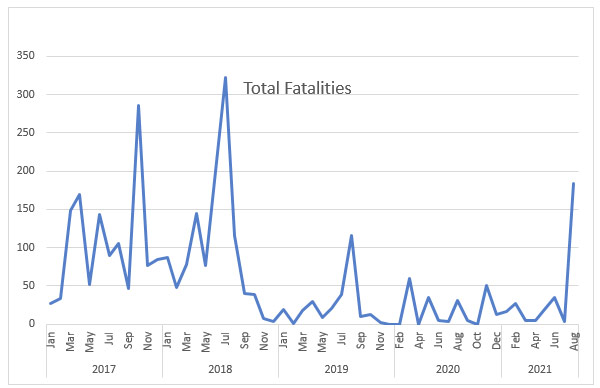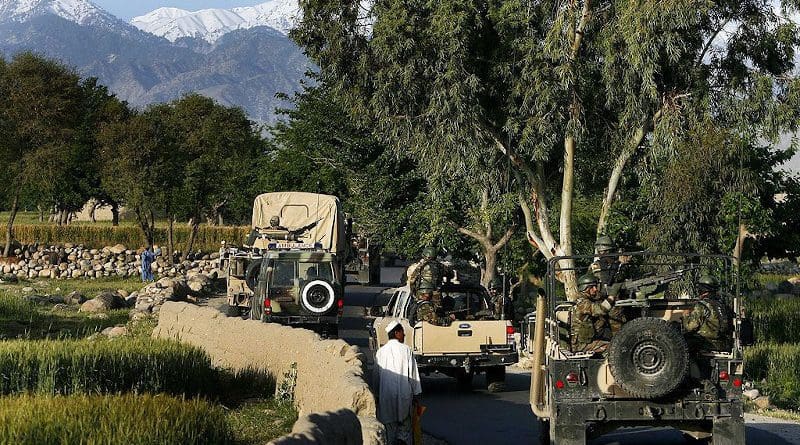Is Threat Of Islamic State Khorasan A Red Herring? – Analysis
By Manohar Parrikar Institute for Defence Studies and Analyses (MP-IDSA)
By Pradeep Singh Gautam*
A new wave of violence has emerged since the US troops’ withdrawal from Afghanistan and the takeover by Taliban. After the Kabul airport attack on 26 August 2021, in which nearly 170 people died including 13 US soldiers, Jalalabad was rocked by bomb blasts on 18–19 September 2021. Islamic State of Khorasan (ISK) has claimed responsibility for these attacks. This existing threat of ISK is being harped upon by various commentators as having potential to destabilise the wider region. How serious and credible is this threat? Pakistan is asking the wider world to cooperate with the Taliban to defeat it. Should we encourage that? If yes, what may be the long-term implications of this cooperation?
For this analysis, let’s first consider the strengths and weaknesses of the threat posed by the ISK.
Who are the ISK?
ISK was formed as a Wilayah (province) of the earlier Islamic State of Syria and Levant (ISIL) in the year 2015. It was initially said to be formed by the disgruntled elements of the Tahreek-e-Taliban Pakistan (TTP) in Orakzai agency of Pakistan, which then shifted across the border to Nangarhar and Kunar in Afghanistan. Subsequently, the disgruntled elements of Taliban, Al Qaida and Haqqani Network joined the ISK.1 Their numbers are estimated to be between 1,500 and 2,2002 .Figure 1 shows the intensity of their attacks since its formation.

Their activity was the highest in year 2017–2018 and then it tapered down. The ostensible reason for this fall post-2018 was due to the concerted action against them by the Afghan and the NATO forces. Figure 1 shows a sudden jump in August 2021 due to the Kabul airport blast. In all this recent buzz around ISK, it is pertinent to analyse how serious this threat is.
In theory, as the Islamic State operates on the ideology of a global caliphate, ISK also, by definition, has a potential global ideological reach. It is known to recruit from across the world. It is noteworthy that as per the reports, a terrorist from Kerala was involved in the Kabul Gurudwara attack.4 Again, Islamic State is known to use extreme and graphic violence to instill terror. Its ideology may also inspire lone wolf attacks. A caveat may be necessary here as many a times lone wolves find ISIL ideology convenient to justify their attacks. It is also seen that many a times ISIL claims random terror attacks for propaganda purposes.
Inherent Limitations
Notwithstanding the aforementioned strengths, there are some distinct weaknesses as well.
First, an Islamic State of this kind requires territory which it controls, a caliph and Dawla (state). As of now, ISIL does not control any territory and their caliph Abu Bakr al-Baghdadi is dead. As the state exists no more, this puts serious questions on the viability of its affiliate province in Khorasan as well.
Second, extreme violence practiced by the ISK may also be ultimately working against them. The Taliban and many other Muslims call the Islamic State fighters as Khawarij, a term used for extremists who are considered as mischief mongers and even branded as non-Muslim. This ideological name calling may not seem very important to an outsider but it remains germane to the final outcome for the parties involved. The genesis of this dispute is nearly as old as Islam itself. During the reign of fourth caliph Ali Ibn Abi Talib a civil war broke out between him and the governor of Damascus, Muaviyah. It led to the Battle of Siffin in 657 AD, during which a compromise was reached between the warring parties. A group of supporters of Ali rebelled against him and blamed him of apostasy, saying that it was not for Ali to compromise in violation of divine will. This dispute led to a lot of bloodshed but the rebels finally succeeded in assassinating Ali. This group was called Khawarij or Khariji, meaning people who withdrew from the religion.5 The same theme is being played out today with some variations. The ISK calls the Taliban Murtad or apostate because, according to them, by negotiating with the US the Taliban have compromised. ISK also finds the Taliban to be “nationalistic” which is also anti-Islamic in its view. In this battle of narratives this label of Khawarij on the ISK is a handicap in its wider growth and acceptance.
Third, the ISK practices Takfir where they declare a Muslim to be an apostate even for minor doctrinal or practical deviation from their version of true Islam.6 This is extreme Salafi/Wahhabi strand in their practice. They want to first purge the Muslim societies of all the “deviations” and “sins”. This makes IS ideology perpetuate more violence and bloodshed within Muslim societies itself. Also, the Islamic State worldview is heavily influenced by the prophecies of doomsday and the day of judgement. They see signs of coming final battle between Muslims and Kuffar everywhere. This virulence, though has shock and awe effect in short term, also acts as a hindrance in their long-term sustenance. Taking a parallel from biology, an extremely virulent strain of some virus may be very dangerous but this virulence itself leads to killing of the host which ultimately limits the virus’s own growth.
Fourth, Islamic State ideology requires its adherent to migrate to the territory controlled by them. Therefore, there are always chances of lone wolf attacks or IS-inspired attacks outside but this migration makes these extremists create more mayhem in the IS-controlled areas only. This phenomenon also indirectly limits their violence-causing capacity outside. So, what can possibly explain its sudden emergence?
Cui Bono?
Right from the beginning there has been some confusion behind who or what is responsible for the emergence of ISIL or ISK? Another angle to the emergence of ISK may be long-held allegation that they are nothing but the cat’s paw of the ISI. Pattern of violence and target selection by the ISK in itself shows that they have been killing Shia Hazaras, Sikhs in Kabul, school-going girls and finally the US soldiers and people who assisted the last regime. By the principle of who benefits, it may be seen that they have been doing nothing new (as in there are other Sunni extremists groups who have been doing exactly the same) or they have only facilitated the Taliban. It is true that now the Taliban and the ISK appear to be fighting but people like Amrullah Saleh and other security experts have long accused the ISK to be doing the Taliban’s dirty jobs.7 Now, when the US is out, ISK may also be used by the ISI to give a not-so-gentle reminder to the Taliban if they break the line and try to be too nationalistic and independent-minded.
This allegation finds credence from the fact that somewhere around 2016, the ISK seemed to have been penetrated by the ISI. The last two Emirs of the ISK, Aslam Farooqi and Shahab al-Muhajjir have been known to have worked for the Haqqani Network.8 Aslam Farooqi also had long connections with the Lashkar-e-Taiba.9 LeT and Haqqani Network are known ISI affiliates.
Both Pakistan and the US are busy overplaying this threat from the ISK for their own reasons. The US wants to save face and avoid the political fallout of its capitulation in Kabul. Pakistan wants to get money and recognition for its perceived foster child in the form of the Taliban. Pakistan itself has become partially Talibanised and it supports its ideological bedfellow. This leads both of them to give the Taliban a somewhat benign colour.
Conclusion
As regard the long-term impact of the possible survival and mainstreaming of the Taliban regime, recent experience has shown that all the wishful thinking of the Taliban having changed their ways is just that. Women rights, rights of minorities, any kind of power sharing with rivals has received a setback. The Taliban remain committed to establish their version of the 7th century utopia with all the floggings, amputations and public stoning. Al Qaida and its South Asian version remains present in Afghanistan and their relationship with the Taliban is still very much intact.10 What makes the ISI and the Taliban more potent threat than the ISK is that they are just one shade rational in their ideology, which increases their chances of survival. They also have better state apparatus and resources at their command. The Taliban also derives their legitimacy from the larger Hanafi Deobandi school which has a vast following in South Asia with a potential to extend this influence. In tandem, the ISI remains committed to continuous jihad and bleeding India through 1,000 cuts. It is not easy to forget that the ISI and Pakistan Army still has Jihad fi Sabillilah as its motto.
In such a scenario, success of the Taliban project will reaffirm this ideology and further mainstream it. But they cannot achieve their objectives without international support. In this game, the ISK may just be a red herring and the proverbial boogey-man to make us all give Pakistan and the Taliban what they want.
Views expressed are of the author and do not necessarily reflect the views of the Manohar Parrikar IDSA or of the Government of India.
*About the author: Pradeep Singh Gautam is an officer of the Indian Revenue Service (IT) of the 2008 batch. Currently serving as Research Fellow at MP-IDSA on deputation.
Source: This article was published by Manohar Parrikar IDSA
- 1.Catrina Doxsee, Jared Thompson and Grace Hwang, “Examining Extremism: Islamic State Khorasan Province (ISKP)”, Center for Strategic and International Studies, 8 September 2021.
- 2.“Letter dated 20 May 2021 from the Chair of the Security Council Committee established pursuant to resolution 1988 (2011) addressed to the President of the Security Council”, United Nations Security Council, S/2021/486, 1 June 2021.
- 3.“Data Export Tool” [Database], The Armed Conflict & Location Event Data Project (ACLED).
- 4.Vijaita Singh, “Kerala Man was Among Kabul Gurdwara Attackers”, The Hindu, 28 March 2020.
- 5.See “Battle of Siffin–Islamic History”, Encyclopedia Britannica. Also see, Mohamed Bin Ali, “Labelling IS fighters: Khawarij, Not Jihadi-Salafis”, RSIS, 4 April 2018.
- 6.Mohamed Bin Ali, “Labelling IS fighters: Khawarij, Not Jihadi-Salafis”, RSIS, 4 April 2018.
- 7.“Amrullah Saleh Says Taliban Denying ISIS Link is like Pak Denying Quetta Shura”, Livemint, 27 August 2021.
- 8.No. 1.
- 9.Devesh K. Pandey, “ISKP has been Attempting to Recruit Indians”, The Hindu, 28 August 2021.
- 10.No. 2.

